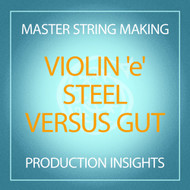Violin 'e' Steel vs. Gut
May 17th 2024
The debate over steel or gut for the violin e-1 string has been ongoing for at least 150 years, with very strong and precise opinions on both sides. This consideration came into sharper focus during and following World War I primarily due to material scarcity.
The Russian Revolution of 1917 decimated any future prospect of exports of quality raw gut material from the Eurasian steppes, while the close of World War I saw Germany effectively ceasing gut string export; all while every country capable was hungry for steel for industry, manufacture, and military (steel itself would become a scarce commodity at the lead-up to World War II, necessitating the innovation of modern synthetic strings).
The Journal of the American Musicological Society notes: “The driving force behind this change was World War I. The conflict shut down the export of gut strings from Germany, the world’s largest producer, and vast quantities of sheep intestines — necessary for gut strings — were desperately needed for sutures.” [The Great War, the Little String, and the Transformation of Modern Violin Playing - Mark Katz. Journal of the American Musicological Society, vol. 77, pp. 65-101, 2024]
Carl Flesch's 1923 Die Kunst des Violin-Spiels (The Art of Playing the Violin) provided his detailed pros and cons on the differences between steel or gut for the violin e-1 string … [continue].

